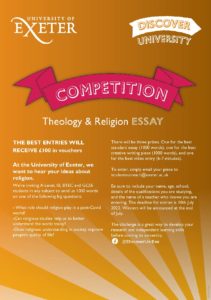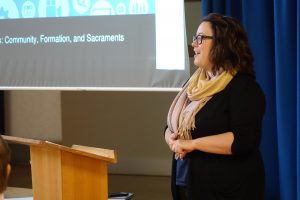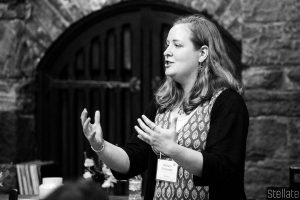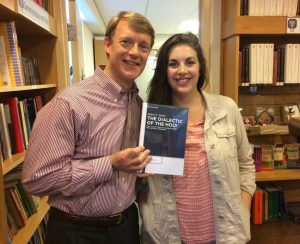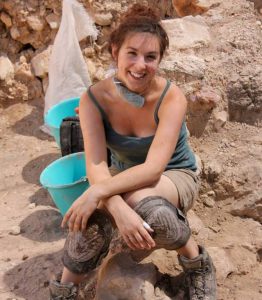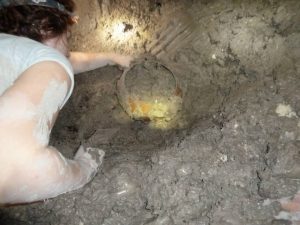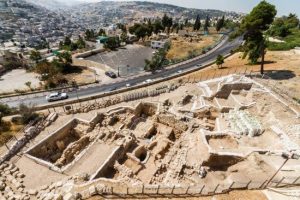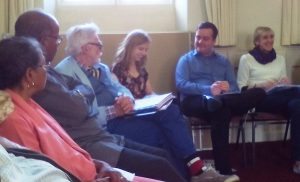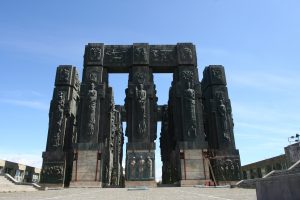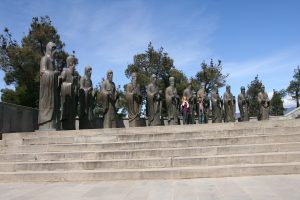In October 2017, several academics from the University of Exeter Theology and Religion Department attended the American Academy of Religion Conference in Boston. Three report on their experiences of the conference.
Professor David Horrell
A busy conference and an overnight flight, followed by the train back to Exeter, leaves me feeling a bit tired, but it was, as always, a very worthwhile and enjoyable time. I presented a paper on J.B. Lightfoot’s reading of 1 Peter, in a session with other speakers (Jeanette Hagen, Todd Still, and Tom Wright), and we had an interesting discussion about Lightfoot as biblical scholar, and the similarities and differences with the discipline and context of today. One of the conference highlights for me (and for many others) was a session on “hair in the Greco-Roman world” – in which Helen Bond, Professor at Edinburgh, had her hair done in the elite Roman style by a scholar and hairstylist, alongside various papers – including one by Troy Martin, from St Xavier University in Chicago, arguing that the date of 1 Peter can be ascertained from the author’s reference to hair-styling (1 Pet 3.3): he argued for sometime after 79 CE, and probably between 79 and 81. My meeting also included chairing an editorial board meeting, meeting with a few PhD students, and also with a publisher, to discuss my next two book projects. And Boston was a good place to be, too!
Dr Louise Lawrence
I have just returned from the annual American Academy of Religion and Society of Biblical Literature Conference (AAR&SBL) in Boston, US. I was on a panel with Dale Martin (Yale) and Dominika Kurek-Chomycz (Chester) in the Luke-Acts and Embodiment Session. Stephen Moore (Duke) incisively (and critically) responded to all three of our contributions. My paper was entitled ‘Coming to her Senses? The Embodiments of a Demon-Possessed Woman in Acts 16’. I sought to probe sensory dimensions of embodiment in relation to the presentation of the Pythian slave-girl – who is variously referred to as a ‘belly-talker’ or ‘ventriloquist’ by commentators. I used recent work on sound, embodiment and the female voice which has contended that voice is not just codified by semantic content, but also its sonorous, non-verbal, embodied features to try and bring this character to life. Classicists and ancient historians have similarly noted how the ancient discipline of physiognomy determined whether people would be judged sane or insane, male or female, honest, marriageable, moribund etc. on account of the embodied sounds they made. Continuing the embodiment theme I also attended a really useful session on God’s Body: Jewish, Christian and Pagan Images of God in Antiquity.
A real highlight for me though has to be the ‘Consultation on the Status of Persons with Disabilities in the Profession’. This was an exploratory session with a view to forming an advisory board on this theme. The presenters powerfully spoke of their experiences of chronic illness, pain, disability and the ‘ableism’ they perceived as inherent in the SBL conference. Some of the suggestions from speakers included very practical advice including video-guides of the conference space, quiet rooms with dipped lighting and softened acoustics, provisions for personal care if needed, and more accessible publications – book synopses for slow readers, or those who ‘read’ in mixed media (Braille; sign etc.). All participants spoke of the need to cultivate a ‘sense of belonging’ for those with disabilities in an academic conference such as SBL, and also the exhaustion of having to continuously advocate in an academy which often seems to be totally oblivious to embodied (and I would add en-minded) diversity. This is a really important initiative and I really hope it can make headway in making SBL a more inclusive space for those with disabilities.
On a team-Exeter note (!) I caught up with Francesca – which was fantastic. Aside from giving papers, she was also acting as an ‘
SBAllie‘ – ‘a presence or resource to support people experiencing harassment of any kind’ at the conference. This role was indicated by the SBAllie badge she wore. This too is a really important initiative. Many people have experienced feeling out of place, excluded or troubled for one reason or another at conferences like SBL, so to have self-identified ‘allies’ who people can talk to confidentially about such issues is a really welcome initiative.
Finally, I attended the editorial board meeting of the
Journal for the Study of the New Testament whilst in Boston. I was also honoured to be confirmed as the editor-elect of this journal. I will be taking over as editor from next summer. This is both an exciting and daunting prospect!
The countdown now begins to AAR&SBL 2018 – in Denver Colorado . . .
Dr David Tollerton
Later this week I’m travelling to Boston, the home of the American Revolution, to talk about ‘British Values’. This isn’t some belated attempt to return the United States to Her Majesty’s rule, but rather to contribute to a wider discussion about religion, history, and education. The term ‘British values’, first coined amidst counter-radicalisation policy, has in recent years become ubiquitous in UK educational contexts, and in my paper I’ll be addressing how this development interacts with issues of religious diversity, national identity-construction, and perceptions of history. Hearing responses to my ideas from a specifically international audience is something I’m especially looking forward to.
Professor David Horrell is Professor of New Testament Studies and the Director of the Centre for Biblical Studies. Dr Louise Lawrence is Senior Lecturer in New Testament studies. Dr David Tollerton is a lecturer in Jewish Studies and Contemporary Biblical Cultures and the Director of Postgraduate Research for the Theology and Religion department.
Also attending the conference from our department were Dr Brandon Gallaher (Lecturer of Systematic and Comparative Theology), Dr Daniel Pedersen (Postdoctoral Research Fellow), Prof Francesca Stavrakopoulou (Professor of Hebrew Bible and Ancient Religion), and Prof Christopher Southgate (Associate Professor of the University of Exeter).

